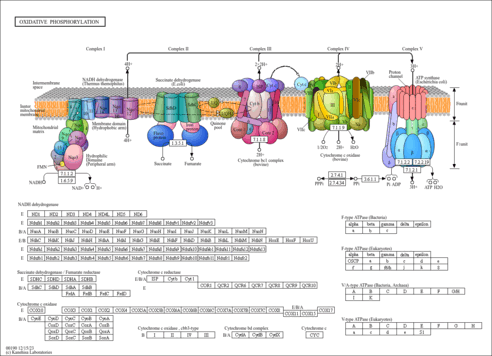| Identification |
|---|
| YMDB ID | YMDB00902 |
|---|
| Name | ubiquinol |
|---|
| Species | Saccharomyces cerevisiae |
|---|
| Strain | Baker's yeast |
|---|
| Description | Ubiquinol 8 belongs to the class of organic compounds known as polyprenyl quinols. Polyprenyl quinols are compounds containing a polyisoprene chain attached to a quinol(hydroquinone) at the second ring position. Ubiquinol 8 is an extremely weak basic (essentially neutral) compound (based on its pKa). |
|---|
| Structure | |
|---|
| Synonyms | - coenzymes QH2
- CoQH2
- QH(2)
- QH2
- reduced ubiquinone
- Ubiquinol
- ubiquinol-8
- ubiquinol(8)
- ubiquinols
- Reduced coenzyme Q8
|
|---|
| CAS number | 56275-39-9 |
|---|
| Weight | Average: 731.1412
Monoisotopic: 730.590010984 |
|---|
| InChI Key | FLVUMORHBJZINO-SGHXUWJISA-N |
|---|
| InChI | InChI=1S/C49H78O4/c1-36(2)20-13-21-37(3)22-14-23-38(4)24-15-25-39(5)26-16-27-40(6)28-17-29-41(7)30-18-31-42(8)32-19-33-43(9)34-35-45-44(10)46(50)48(52-11)49(53-12)47(45)51/h20,22,24,26,28,30,32,34,46-47,50-51H,13-19,21,23,25,27,29,31,33,35H2,1-12H3/b37-22+,38-24+,39-26+,40-28+,41-30+,42-32+,43-34+ |
|---|
| IUPAC Name | 2,3-dimethoxy-5-methyl-6-[(2E,6E,10E,14E,18E,22E,26E)-3,7,11,15,19,23,27,31-octamethyldotriaconta-2,6,10,14,18,22,26,30-octaen-1-yl]benzene-1,4-diol |
|---|
| Traditional IUPAC Name | ubiquinol-8 |
|---|
| Chemical Formula | C49H78O4 |
|---|
| SMILES | COC1=C(OC)C(O)C(C\C=C(/C)CC\C=C(/C)CC\C=C(/C)CC\C=C(/C)CC\C=C(/C)CC\C=C(/C)CC\C=C(/C)CCC=C(C)C)=C(C)C1O |
|---|
| Chemical Taxonomy |
|---|
| Description | belongs to the class of organic compounds known as polyprenyl quinols. Polyprenyl quinols are compounds containing a polyisoprene chain attached to a quinol(hydroquinone) at the second ring position. |
|---|
| Kingdom | Organic compounds |
|---|
| Super Class | Lipids and lipid-like molecules |
|---|
| Class | Prenol lipids |
|---|
| Sub Class | Quinone and hydroquinone lipids |
|---|
| Direct Parent | Polyprenyl quinols |
|---|
| Alternative Parents | |
|---|
| Substituents | - Tetraterpenoid
- 2-polyprenyl-6-methoxyphenol
- Polyprenylbenzoquinol
- Polyprenylphenol
- Ubiquinol skeleton
- Methoxyphenol
- O-dimethoxybenzene
- Dimethoxybenzene
- Anisole
- Hydroquinone
- M-cresol
- Phenoxy compound
- O-cresol
- Phenol ether
- Methoxybenzene
- Alkyl aryl ether
- Phenol
- Toluene
- Monocyclic benzene moiety
- Benzenoid
- Ether
- Organooxygen compound
- Organic oxygen compound
- Hydrocarbon derivative
- Aromatic homomonocyclic compound
|
|---|
| Molecular Framework | Aromatic homomonocyclic compounds |
|---|
| External Descriptors | |
|---|
| Physical Properties |
|---|
| State | Solid |
|---|
| Charge | 0 |
|---|
| Melting point | 45.6 °C |
|---|
| Experimental Properties | | Property | Value | Reference |
|---|
| Water Solubility | Not Available | PhysProp | | LogP | Not Available | PhysProp |
|
|---|
| Predicted Properties | |
|---|
| Biological Properties |
|---|
| Cellular Locations | Not Available |
|---|
| Organoleptic Properties | Not Available |
|---|
| SMPDB Pathways | |
|---|
| KEGG Pathways | |
|---|
| SMPDB Reactions | Not Available |
|---|
| KEGG Reactions | Not Available |
|---|
| Concentrations |
|---|
| Intracellular Concentrations | Not Available |
|---|
| Extracellular Concentrations | Not Available |
|---|
| Spectra |
|---|
| Spectra | | Spectrum Type | Description | Splash Key | View |
|---|
| Predicted GC-MS | Predicted GC-MS Spectrum - GC-MS (TMS_1_1) - 70eV, Positive | Not Available | JSpectraViewer | | Predicted GC-MS | Predicted GC-MS Spectrum - GC-MS (TMS_1_2) - 70eV, Positive | Not Available | JSpectraViewer | | Predicted GC-MS | Predicted GC-MS Spectrum - GC-MS (TMS_2_1) - 70eV, Positive | Not Available | JSpectraViewer | | Predicted GC-MS | Predicted GC-MS Spectrum - GC-MS (TBDMS_1_1) - 70eV, Positive | Not Available | JSpectraViewer | | Predicted GC-MS | Predicted GC-MS Spectrum - GC-MS (TBDMS_1_2) - 70eV, Positive | Not Available | JSpectraViewer | | Predicted LC-MS/MS | Predicted LC-MS/MS Spectrum - 10V, Positive | splash10-004i-0323324900-8d5262afd36dcbc7148a | JSpectraViewer | | Predicted LC-MS/MS | Predicted LC-MS/MS Spectrum - 20V, Positive | splash10-0032-1648692100-f4b35e5836e1b0685dbe | JSpectraViewer | | Predicted LC-MS/MS | Predicted LC-MS/MS Spectrum - 40V, Positive | splash10-0532-5487958100-34e9af02e9a7005e70a4 | JSpectraViewer | | Predicted LC-MS/MS | Predicted LC-MS/MS Spectrum - 10V, Negative | splash10-004i-0000000900-456744203daa0fca5d76 | JSpectraViewer | | Predicted LC-MS/MS | Predicted LC-MS/MS Spectrum - 20V, Negative | splash10-0h00-0000009500-add178adb113c4e8faa3 | JSpectraViewer | | Predicted LC-MS/MS | Predicted LC-MS/MS Spectrum - 40V, Negative | splash10-03k9-3000019100-471dfb54d9e8cb8939f8 | JSpectraViewer | | Predicted LC-MS/MS | Predicted LC-MS/MS Spectrum - 10V, Positive | splash10-057j-6405569600-34b9f4abc22e1814c315 | JSpectraViewer | | Predicted LC-MS/MS | Predicted LC-MS/MS Spectrum - 20V, Positive | splash10-000t-4904532000-2ec1e0341ea818671a91 | JSpectraViewer | | Predicted LC-MS/MS | Predicted LC-MS/MS Spectrum - 40V, Positive | splash10-0036-9613310000-3825f8084c00c72645ec | JSpectraViewer | | Predicted LC-MS/MS | Predicted LC-MS/MS Spectrum - 10V, Negative | splash10-004i-0000000900-753eb68b8e8835d49d63 | JSpectraViewer | | Predicted LC-MS/MS | Predicted LC-MS/MS Spectrum - 20V, Negative | splash10-00mk-0910108500-1324247480f23e6031ea | JSpectraViewer | | Predicted LC-MS/MS | Predicted LC-MS/MS Spectrum - 40V, Negative | splash10-001i-0942167000-3f62ea4336556f2f28ce | JSpectraViewer |
|
|---|
| References |
|---|
| References: | - UniProt Consortium (2011). "Ongoing and future developments at the Universal Protein Resource." Nucleic Acids Res 39:D214-D219.21051339
- Scheer, M., Grote, A., Chang, A., Schomburg, I., Munaretto, C., Rother, M., Sohngen, C., Stelzer, M., Thiele, J., Schomburg, D. (2011). "BRENDA, the enzyme information system in 2011." Nucleic Acids Res 39:D670-D676.21062828
- Swida-Barteczka, A., Woyda-Ploszczyca, A., Sluse, F. E., Jarmuszkiewicz, W. (2009). "Uncoupling protein 1 inhibition by purine nucleotides is under the control of the endogenous ubiquinone redox state." Biochem J 424:297-306.19747168
- Schultz, J. R., Ellerby, L. M., Gralla, E. B., Valentine, J. S., Clarke, C. F. (1996). "Autoxidation of ubiquinol-6 is independent of superoxide dismutase." Biochemistry 35:6595-6603.8639607
|
|---|
| Synthesis Reference: | Not Available |
|---|
| External Links: | |
|---|

